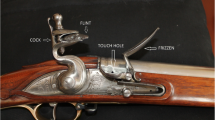Abstract
Gunflints are of particular interest to historical archaeologists. One process of manufacture involved the wedge-shaped gunspall, which has been attributed to a Dutch origin, and is dated between 1650 and 1770. Upon examination, the argument for the Netherlands as the source is not substantiated.
The terminal dates for this chronology coincide approximately with documentation for the introduction of the French blade technique to England, replacing gunspall-making. Composite evidence is provided from refuse of gunspall production found in English archaeological sites, written evidence for the existence of an “English Hammer,” and gunspalls found in archaeological sites. All these variables are related to each other in terms of manufacture. Nevertheless gunspalls cannot be attributed solely to England. Tentative evidence is provided for their manufacture in France. Gunspalls were definitely made in Denmark. Evidence is also available on the manufacture of gunspalls from flint ballast at Fort Frederica, Georgia.
Similar content being viewed by others
References
Barnes, Alfred S. 1937 L’industrie des pierres à fusil par la méthode anglaise et son rapport avec le coup de burin tardenoisien. Bulletin—Société Préhistorique Française, Vol. 14, pp. 328–35.
Beckman, Johann 1846 History of Inventions, Discoveries, and Origins. Translated by William Johnston from Beytrage zur Geschicte der Erfindungen, 1783–1805, 2nd ed. Bohn Standard Library, Vol. 2, London.
Brard, C. D. 1821 Minéralogie appliquée aux arts. F. G. Levrault, Paris.
Chandler, R. H. 1917 Some Supposed Gun-flint Sites. Proceedings of the Prehistoric Society of East Anglia, Vol. 2, pp. 360–65. Cambridge.
Clarke, Rainbird 1935 The Flint Knapping Industry at Brandon. Antiquity, Vol. 9, pp. 38–56. Cambridge.
Clay, C. C. 1925 Gun-flint Factory in South Wilts. The Antiquaries Journal, Vol. 5, pp. 423–26. Oxford.
Dixie Gun Works 1974 Dixie Gun Works, Inc., Catalogue No. 123. Union City, Tennessee.
Dolomieu, Citoyen 1797 Memoir sur l’art de tailler les pierres à fusil (silex pyromaque). Journal des Mines, Vol. 6, pp. 693–712. Paris.
Emery, K. O., C. A. Kaye, P. H. Loring and D. J. G. Nota 1968 European Cretaceous Flints on the Coast of North America. Science, Vol. 160, pp. 1225–27. Washington.
Emy, Jean and Bernard de Tinguy 1964 Histoire de la pierre à fusil. Privately printed, Meusnes, France.
Evans, Arthur J. 1887 On the Flint-knappers’ Art in Albania. Journal of the Royal Anthropological Institute of Great Britain and Ireland, Vol. 16, pp. 65–68. London.
Foundation for the Scientific Atlas of the Netherlands 1963–72 Atlas of the Netherlands. Government Printing and Publishing Office, The Hague.
Gillet-Laumont, F. P. N. 1797 Extraid d’un memoire du Citoyen Salivet, sur la fabrication des pierres à fusil dans les departements de l’Indre et de Loir-et-Cher; avec l’indication de quelques autres lieux où il s’en fabrique également. Journal des Mines, Vol. 6, No. 33, pp. 713–22. Paris.
Hamilton, T. M. 1960 Additional Comments on Gunflints. In “Indian Trade Guns”, edited by T. M. Hamilton, pp. 73–79. The Missouri Archæologist, Vol. 22. Columbia, Missouri.
1964 Recent Developments in the Use of Gun-flints for Dating and Identification. In Diving into the Past, edited by J. D. Holmquist and A. M. Wheeler, pp. 52–57. Minnesota Historical Society, St. Paul
1968 A Review of “A History of Gunflints” by John Witthoft. Historical Archæology 1968, Vol. 2, pp. 116–17. Lansing, Michigan.
Hanson, Lee H., Jr. 1970 Gunflints from the Macon Plateau. Historical Archæology 1970, Vol. 4, pp. 51–58. Lansing, Michigan.
1971 A Reply to Gunflints and Chronology at Ocmulgee National Monument. Historical Archæology 1971, Vol. 5, pp. 109–11. Lansing, Michigan.
Hess, Carsten 1968 De Glemte Flinthuggere fra Stebns. Skalk, No. 5, pp. 9–15. Copenhagen.
Jacobson, J. K. G. 1781 Technologisches Wörterbuch. Freibrich Nicolai, Berlin.
Kendall, H. G. O. 1925 Some Flint Tools of the Iron Age: A Single Series. The Antiquaries Journal, Vol. 5, pp. 158–63. Oxford.
Knowles, Sir Francis H. S., and Alfred S. Barnes 1937 Manufacture of Gun-flints. Antiquity, Vol. 12, pp. 201–07. Cambridge.
Lampe, David, Jr. 1957 Cave Man Munitions Monopoly. The American Rifleman, Vol. 105, No. 6, p. 22. Washington.
Lavin, James D. 1965 A History of Spanish Firearms. Herbert Jenkins, London.
Levesque, Réné 1973 Typologie des pierres-à-fusil des gisements de Sept-Iles et de Mingan. Educo-Media, Ottawa.
Mitchell, James 1837 On the Manufacture of Gun-flints. Edinburgh New Philosophical Journal, Vol. 22, pp. 36–40. Edinburgh.
Natividade, M. Vieira 1893 La taille du silex au XIX siècle. A. Coelho Da Silva, Alcobaca, Portugal.
Pfeiffer, Ludwig 1912 Die Steinzeitliche Technik. Verlag Von Gustav Fischer, Jena.
Rees, Abraham 1819 Flint. The Cyclopedia, or Universal Dictionary of Useful Arts, Science and Literature, Vol. 14. Samuel F. Bradford and Murray, Fairman and Co., Philadelphia.
Rogers, H. C. B. 1960 Weapons of the British Soldier. Seeley, Service and Co., London.
Russell, Carl P. 1962 Guns of the Early Frontier. Bonanza Books, New York.
Salmon, Philippe 1885 La fabrication des pierres à feu en France. A Hennuyer, Paris. Sieveking, G. de. G., P. Bush, J. Ferguson, P. T. Craddock. M. J. Hughes and M. R. Cowell
1972 Prehistoric Flint Mines and their Identification as Sources of Raw Material. Archæometry, Vol. 14, pp. 151–57. London.
Skertchly, Sydney B. J. 1879 On the Manufacture of Gun-flints, the Methods of Excavating for Flint, the Age of Palaeolithic Man, and the Connexion between Neolithic Art and the Gun-flint Trade. Memoirs of the Geological Survey, England and Wales. Her Majesty’s Stationary Office, London.
Stone, Lyle 1971 Gunflints from Eighteenth Century Fort Michilimackinac, Michigan: A Formal Analysis and Description. Conference on Historic Site Archæology Papers, Vol. 5, pp. 1–34. Columbia, South Carolina.
Tomlinson, Charles 1852 Flint. The Cyclopaedia of Useful Arts and Manufactures, Vol. 1, pp. 688–90. John S. Virtue, London.
White, Stephen W. 1975 Gunflints: Their Possible Significance for the Northwest. Northwest Anthropological Research Notes, Vol. 9, No. 1, pp. 51–69. Moscow, Idaho.
Witthoft, John 1966 A History of Gunflints. Pennsylvania Archæologist, Vol. 36, Nos. 1–2, pp. 12–49. Gettysburg, Pennsylvania.
Rights and permissions
About this article
Cite this article
White, S.W. On the origins of gunspalls. Hist Arch 9, 65–73 (1975). https://doi.org/10.1007/BF03373431
Published:
Issue Date:
DOI: https://doi.org/10.1007/BF03373431




